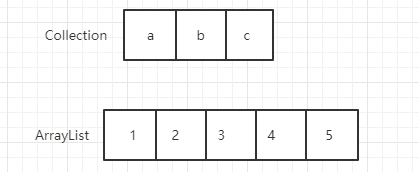ArrayList概述
ArrayList是一个的可变数组的实现,实现了所有可选列表操作,并允许包括 null 在内的所有元素。每个ArrayList实例都有一个容量,该容量是指用来存储列表元素的数组的大小。它总是至少等于列表的大小。随着向ArrayList中不断添加元素,其容量也自动增长。自动增长会带来数据向新数组的重新拷贝,因此,如果可预知数据量的多少,可在构造ArrayList时指定其容量。在添加大量元素前,应用程序也可以使用ensureCapacity操作来增加ArrayList实例的容量,这可以减少递增式再分配的数量。
注意,此实现不是同步的。如果多个线程同时访问一个ArrayList实例,而其中至少一个线程从结构上修改了列表,那么它必须保持外部同步。
ArrayList的源码阅读:
- 底层容器
ArrayList是一个Object的数组,还有一个size属性来记录当前容器的容量。
transient Object[] elementData; // non-private to simplify nested class access
private int size;
- 构造函数
ArrayList提供了三种方式的构造器,可以构造一个默认初始容量为0的空列表、构造一个指定初始容量的空列表以及构造一个包含指定collection的元素的列表,这些元素按照该collection的迭代器返回它们的顺序排列的。
private static final Object[] EMPTY_ELEMENTDATA = {};
private static final Object[] DEFAULTCAPACITY_EMPTY_ELEMENTDATA = {};
// 传入初始容量的构造函数
public ArrayList(int initialCapacity) { if (initialCapacity > 0) { this.elementData = new Object[initialCapacity]; } else if (initialCapacity == 0) { this.elementData = EMPTY_ELEMENTDATA; } else { throw new IllegalArgumentException("Illegal Capacity: "+ initialCapacity); } } // 默认的构造函数 public ArrayList() {
// 默认的是一个空数组实例,等用到的时候再扩容 this.elementData = DEFAULTCAPACITY_EMPTY_ELEMENTDATA; }
// 传入外部集合的构造函数 public ArrayList(Collection<? extends E> c) {
//持有传入集合的内部数组的引用 elementData = c.toArray();
//更新集合元素个数大小 if ((size = elementData.length) != 0) { // c.toArray might (incorrectly) not return Object[] (see 6260652) if (elementData.getClass() != Object[].class)
//判断引用的数组类型, 并将引用转换成Object数组引用 elementData = Arrays.copyOf(elementData, size, Object[].class); } else { // replace with empty array. this.elementData = EMPTY_ELEMENTDATA; } }
- 添加元素
ArrayList有四种添加元素的方法:add(E e),add(int index, E element),addAll(Collection<? extends E> c),addAll(int index, Collection<? extends E> c)
// 添加一个元素
public boolean add(E e) {
//添加前先检查是否需要拓展数组, 此时数组长度最小为size+1 ensureCapacityInternal(size + 1); // Increments modCount!!
//将元素添加到数组末尾 elementData[size++] = e; return true; } // 插入一个元素 public void add(int index, E element) {
//插入位置范围检查 rangeCheckForAdd(index); //检查是否需要扩容 ensureCapacityInternal(size + 1); // Increments modCount!!
//挪动插入位置后面的元素 System.arraycopy(elementData, index, elementData, index + 1, size - index);
//在要插入的位置赋上新值 elementData[index] = element;
//将容器的容量+1 size++; }
// 添加一个集合数据 public boolean addAll(Collection<? extends E> c) {
// 把Collection中的数据按照迭代器的排列复制到临时数组a中 Object[] a = c.toArray(); int numNew = a.length;
// 检查是否需要扩容 ensureCapacityInternal(size + numNew); // Increments modCount
// 将数据插入到容器的末尾 System.arraycopy(a, 0, elementData, size, numNew);
// 更新容器的容量 size += numNew; return numNew != 0; } // 插入一个集合数据 public boolean addAll(int index, Collection<? extends E> c) {
// 插入范围检查 rangeCheckForAdd(index); Object[] a = c.toArray(); int numNew = a.length;
//检查是否需要扩容 ensureCapacityInternal(size + numNew); // Increments modCount int numMoved = size - index; if (numMoved > 0)
// 在elementData的index位置开始,往后移动numNew个位置 System.arraycopy(elementData, index, elementData, index + numNew, numMoved); // 将数据插入的index处 System.arraycopy(a, 0, elementData, index, numNew); size += numNew; return numNew != 0; }
细读里面上的代码:
- System.arraycopy
System.arraycopy(elementData, index, elementData, index + numNew,numMoved);

这时的index=1 numNew=3,numMoved=4,那么执行上面的代码后:

然后执行
System.arraycopy(a, 0, elementData, index, numNew);

2. ensureCapacityInternal
//集合最大容量
private static final int MAX_ARRAY_SIZE = Integer.MAX_VALUE - 8; private void ensureCapacityInternal(int minCapacity) {
// 如果是空数组(默认初始化时的数组) if (elementData == DEFAULTCAPACITY_EMPTY_ELEMENTDATA) {
// 容量不能小于默认容量10 minCapacity = Math.max(DEFAULT_CAPACITY, minCapacity); } ensureExplicitCapacity(minCapacity); } private void ensureExplicitCapacity(int minCapacity) {
// 更新容器被修改的次数 modCount++; // overflow-conscious code
//如果最小容量大于数组长度就扩增数组 if (minCapacity - elementData.length > 0) grow(minCapacity); }
//增加数组的长度 private void grow(int minCapacity) { // overflow-conscious code
//获取数组原先的容量 int oldCapacity = elementData.length;
// 新数组容量,在原来的基础上增加1.5倍 int newCapacity = oldCapacity + (oldCapacity >> 1);
//检查新的容量是否小于最小容量 if (newCapacity - minCapacity < 0) newCapacity = minCapacity;
//检查新的容量是否超过最大数组容量 if (newCapacity - MAX_ARRAY_SIZE > 0) newCapacity = hugeCapacity(minCapacity); // minCapacity is usually close to size, so this is a win:
// 增加新容量的数组,并把原先的数据拷贝到新容量的数组 elementData = Arrays.copyOf(elementData, newCapacity); } private static int hugeCapacity(int minCapacity) { if (minCapacity < 0) // overflow throw new OutOfMemoryError(); return (minCapacity > MAX_ARRAY_SIZE) ? Integer.MAX_VALUE : MAX_ARRAY_SIZE; }
每次添加元素前会调用ensureCapacityInternal这个方法进行集合容量检查。在这个方法内部会检查当前集合的内部数组是否还是个空数组,如果是就新建默认大小为10的Object数组。如果不是则证明当前集合已经被初始化过,那么就调用ensureExplicitCapacity方法检查当前数组的容量是否满足这个最小所需容量,不满足的话就调用grow方法进行扩容。
在grow方法内部可以看到,每次扩容都是增加原来数组长度的一半,扩容实际上是新建一个容量更大的数组,将原先数组的元素全部复制到新的数组上,然后再抛弃原先的数组转而使用新的数组。
- 删除元素
// 删除指定下标的元素
public E remove(int index) {
//index不能大于size
rangeCheck(index);
//更新容器被修改的次数
modCount++;
E oldValue = elementData(index);
int numMoved = size - index - 1;
if (numMoved > 0)
//将index后面的值往前移一位
System.arraycopy(elementData, index+1, elementData, index,
numMoved);
//清空最后一个元素
elementData[--size] = null; // clear to let GC do its work
return oldValue;
}
// 删除对象元素
public boolean remove(Object o) {
if (o == null) {
for (int index = 0; index < size; index++)
if (elementData[index] == null) {
fastRemove(index);
return true;
}
} else {
for (int index = 0; index < size; index++)
if (o.equals(elementData[index])) {
fastRemove(index);
return true;
}
}
return false;
}
private void fastRemove(int index) {
modCount++;
int numMoved = size - index - 1;
if (numMoved > 0)
System.arraycopy(elementData, index+1, elementData, index,
numMoved);
elementData[--size] = null; // clear to let GC do its work
}
- 修改元素
public E set(int index, E element) { rangeCheck(index); E oldValue = elementData(index); elementData[index] = element; return oldValue; }
- 查询元素
public E get(int index) { rangeCheck(index); return elementData(index); }
- 增删改查总结
增(添加):仅是将这个元素添加到末尾。操作快速。如果有扩容的情况,会涉及数组的复制,操作较慢。
增(插入):由于需要移动插入位置后面的元素,并且涉及数组的复制,所以操作较慢。
删:由于需要将删除位置后面的元素向前挪动,也会设计数组复制,所以操作较慢。
改:直接对指定位置元素进行修改,不涉及元素挪动和数组复制,操作快速。
查:直接返回指定下标的数组元素,操作快速。
- Fail-Fast机制
ArrayList也采用了快速失败的机制,通过记录modCount参数来实现。在面对并发的修改时,迭代器很快就会完全失败,而不是冒着在将来某个不确定时间发生任意不确定行为的风险。在看下面iterator()方法的源代码时会发现,再通过迭代器操作ArrayList时都会调用checkForComodification方法,如果modCount被修改了会抛出ConcurrentModificationException.
public Iterator<E> iterator() { return new Itr(); } /** * An optimized version of AbstractList.Itr */ private class Itr implements Iterator<E> { int cursor; // index of next element to return int lastRet = -1; // index of last element returned; -1 if no such int expectedModCount = modCount; public boolean hasNext() { return cursor != size; } @SuppressWarnings("unchecked") public E next() { checkForComodification(); int i = cursor; if (i >= size) throw new NoSuchElementException(); Object[] elementData = ArrayList.this.elementData; if (i >= elementData.length) throw new ConcurrentModificationException(); cursor = i + 1; return (E) elementData[lastRet = i]; } public void remove() { if (lastRet < 0) throw new IllegalStateException(); checkForComodification(); try { ArrayList.this.remove(lastRet); cursor = lastRet; lastRet = -1;
// 把modCount重新赋值,所以我们可以使用iterator的remove方法来删除ArrayList里的元素,而不会导致ConcurrentModificationException. expectedModCount = modCount; } catch (IndexOutOfBoundsException ex) { throw new ConcurrentModificationException(); } } @Override @SuppressWarnings("unchecked") public void forEachRemaining(Consumer<? super E> consumer) { Objects.requireNonNull(consumer); final int size = ArrayList.this.size; int i = cursor; if (i >= size) { return; } final Object[] elementData = ArrayList.this.elementData; if (i >= elementData.length) { throw new ConcurrentModificationException(); } while (i != size && modCount == expectedModCount) { consumer.accept((E) elementData[i++]); } // update once at end of iteration to reduce heap write traffic cursor = i; lastRet = i - 1; checkForComodification(); } final void checkForComodification() { if (modCount != expectedModCount) throw new ConcurrentModificationException(); } }